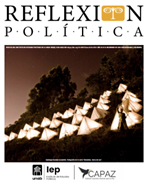Participaciones bajo riesgo en la justicia transicional, el caso de la Jurisdicción Especial para la Paz - JEP
Resumen
Con base en un estudio en la región del Urabá este artículo aborda las consecuencias concretas de la violencia armada en
el funcionamiento de la JEP, jurisdicción que combina los enfoques de la justicia penal retributiva y la justicia restaurativa
para contribuir a la justicia, la verdad y la reconstrucción del tejido social, mediante la participación efectiva y significativa
tanto de las víctimas y como de los comparecientes. En este marco, el artículo contribuye a la identificación y comprensión
de los riesgos concretos que la persistencia de violencias representa para la participación en procesos de justicia
transicional. Se analiza cómo la participación de los principales actores se puede ver restringida de diversas maneras,
dando lugar a un “efecto dominó” de impacto negativo sobre los objetivos de la JEP como el acceso a la verdad, la justicia
y la reconciliación.
Referencias bibliográficas
Álvarez Giraldo, E. E. y Pimienta Betancur, A. (2021). La ‘pacificación’ y la ‘paz territorial’ en Urabá como lógicas espaciales de la paz. Bitácora Urbano Territorial 32(1), 73-84. doi: https://doi.org/10.15446/bitacora.v32n1.98476
Arciniegas, Y. (2021, April 20). Colombia: 1.184 líderes sociales y excombatientes de las FARC asesinados desde 2016. France24. https://www.france24.com/es/am%C3%A9rica-latina/20210420-colombia-asesinatos-lideres-sociales-exfarc-jep
Boyle, M. (2014). Violence after war: Explaining instability in post-conflict societies. John Hopkins University Press.
Bronwyn, H. (2006). Between a Rock and a Hard Place: Violence, Transition and Democratisation. Centre for the Study of Violence and Reconciliation.
Cámara de Comercio de Urabá (2021). Estudio socioeconómico 2020, 22. https://ccuraba.org.co/site/wp-content/uploads/2021/01/INFORME-SOCIO-ECONOMICO-2020.pdf
CEPAL (2018). Panorama Social de América Latina, 21.https://www.cepal.org/es/publicaciones/44395-panorama-social-america-latina-2018
Cohen, S. (1995). State Crimes of Previous Regimes: Knowledge, Accountability, and the Policing of the Past. Law & Social Inquiry, 20(1), 7-50. doi: https://doi.org/10.1086/492497
Cote Barco, G. (2019). El carácter dialógico del proceso con reconocimiento de responsabilidad ante la Jurisdicción Especial para la Paz: retos del derecho penal en contextos de justicia transicional. Vniversitas, 69. doi: https://doi.org/10.11144/Javeriana.vj69.cdpr
Defensoría del pueblo (2022). Informe Defensorial sobre los riesgos colectivos de lideresas y defensoras de derechos humanos en Antioquia, 59. https://colombia.unwomen.org/sites/default/files/2022-3/InformeAntioquita_Digital.pdf
De Waardt, M. & Parmentier, S. (2019). Beyond Victims’ Mere Presence: An Empirical Analysis of Victim Participation in Transitional Justice in Colombia. Journal of Human Rights Practice, 11(1), 209-228. doi: https://doi.org/10.1093/jhuman/huz002
Doak, J. (2011). The therapeutic Dimension of Transitional Justice: Emotional repair and victim satisfaction in international trials and truth commissions. International Criminal Law Review, 11(2), 263-298. doi: https://doi.org/10.1163/157181211X559671
Firchow, P. & Selim, Y. (2022). Meaningful Engagement from the Bottom-Up? Taking Stock of Participation in Transitional Justice Processes. International Journal of Transitional Justice, 16(2), 187-203. doi: https://doi.org/10.1093/ijtj/ijab031
Gamboa Tapias, C. & Díaz Pabón, F. A. (2018). The transitional justice framework agreed between the Colombian government and the FARC-EP. En F. A. Díaz Pabón. Truth, Justice and Reconciliation in Colombia: Transitioning from Violence (pp. 66-84). Routledge. doi: https://doi.org/10.4324/9781315148373-5
Garbett, C. (2017). The International Criminal Court and Restorative Justice: Victims, Participation, and the Processes of Justice. Restorative Justice 5(2), 198-220. doi: https://doi.org/10.1080/20504721.2017.1339953
Gartner, R. & Kennedy, L. (2018). War and Postwar Violence. Crime and Justice 47(1), 1–67. doi: https://doi.org/10.1086/696649
Gready, P. & Robins, S. (2019). From Transitional to Transformative Justice. Cambridge: Cambridge University Press. doi: https://doi.org/10.1017/9781316676028
Hayner, P. (2002). Unspeakable Truths: Facing the Challenge of Truth Commissions. Routledge. doi: https://doi.org/10.4324/9780203903452
Hudson B. (2003). ‘Victims and Offenders’. En A. Von Hirsch, J.V. Roberts, A. Bottoms von, A. E. Roach, and M. Schiff (Eds.). Restorative Justice and Criminal Justice: Competing or Reconcilable Paradigms? (pp. 177-194). Hart Publishing.
Indepaz. (2021). Cinco años del Acuerdo de Paz. Balance en cifras de la violencia de los territorios. https://indepaz.org.co/5-anos-del-acuerdo-de-paz-balance-en-cifras-de-la-violencia-en-los-territorios/
Janetsky, Megan. (2022, September 22). Colombian leader´s promis of “total peace” may prove too ambitious. The Guardian. https://www.theguardian.com/world/2022/sep/22/colombia-gustavo-petro-total-peace
JEP. (2024). Los casos de la JEP. www.jep.gov.co/Paginas/casos.aspx
JEP Colombia. (2022, 21 de junio). Día 1. Audiencia de Reconocimiento Caso 01 (Secuestros de las Farc-EP [Video]. https://www.youtube.com/watch?v=KckiSIEZRcY&t=1s https://www.youtube.com/watch?v=4ulsZ4iBpAI&t=38455s
JEP Colombia. Asesinatos de líderes y lideresas sociales, defensores de derechos humanos y excombatientes de las FARC. https://app.powerbi.com/view?r=eyJrIjoiMDZkNzJjMGYtYzBiYS00NTYxLTkxZTctMDFhYmRkY2Q2MWRlIiwidCI6ImQ3MjlkMmMxLTk4OWUtNDRlNS1iN2M1LTE4MmM5MTRhYzYwNyIsImMiOjR9
Knight, M. y Özerdem, A. (2004). Guns, Camps and Cash: Disarmament, Demobilization and Reinsertion of Former Combatants in Transitions from War to Peace. Journal of Peace Research, 41(4), 499. doi: https://doi.org/10.1177/0022343304044479
Kroc Institute for International Peace Studies. (2019). Estado efectivo de implementación del acuerdo de paz de Colombia. 2 años de implementación. Informe 3, Diciembre 2016 – Diciembre 2018.
Kurtenbach, Sabine. (2014). Postwar Violence in Guatemala: A Mirror of the Relationship between Youth and Adult Society. International Journal of Conflict and Violence, 8(1), 119-133.
Laplante, L. J. (2008). Transitional Justice and Peace Building: Diagnosing and Addressing the Socioeconomic Roots of Violence through a Human Rights Framework. International Journal of Transitional Justice, 2(3), 331-355. doi: https://doi.org/10.1093/ijtj/ijn031
Licklider, R. (2001). Obstacles to peace settlements. En Crocker, C. A., Osler Hampson, F. & Aall, P. (Eds.), Turbulent peace: the challenges of managing international conflicto (pp.697-718), US Institute of Peace Press.
Maher, D. & Thomson, A. (2018). A precarious peace? The threat of paramilitary violence to the peace process in Colombia. Third World Quarterly, 39(11), 2142–2172. doi: https://doi.org/10.1080/01436597.2018.1508992
Mani, R. (2008). Dilemmas of expanding transitional justice, or forging the nexus between transitional justice and development. The International Journal of Transitional Justice, 2(3), 253-265. doi: https://doi.org/10.1093/ijtj/ijn030
McDermott, Y. (2016). Fairness in International Criminal Trials. Oxford University Press. doi: https://doi.org/10.1093/acprof:oso/9780198739814.001.0001
Miller, Z. (2008). ‘Effects of Invisibility: In Search of the ‘Economic’ in Transitional Justice’. International Journal of Transitional Justice, 2(3), 266-291. doi: https://doi.org/10.1093/ijtj/ijn022
Nickson, R. (2016). Participation as Restoration: The Current Limits of Restorative Justice for Victim Participants. En International Criminal Trials. In K. Clamp (Ed.). Restorative Justice in Transitional Settings (pp. 95-114). Routledge. doi: https://doi.org/10.4324/9781315723860-6
Nussio, E. & Howe, K. (2016). When Protection Collapses: Post-Demobilization Trajectories of Violence. Terrorism and Political Violence, 28(5), 848-867. doi: https://doi.org/10.1080/09546553.2014.955916
ONU, Consejo de Derechos Humanos, A/HRC/34/62.
ONU (2016), Report of the Special Rapporteur on the Promotion of Truth, Justice, Reparation and Guarantees of Non-Recurrence, UN Doc. A/34/62, 27.
Prem, M., Rivera, A., Romero, D. A., Vargas Duque, J. F. (2018). Killing social leaders for territorial control: the unintended consequences of peace. Documentos de Trabajo, 218, 1. doi: https://doi.org/10.2139/ssrn.3203065
Redacción Colombia. (2022, abril 27). El inédito reconocimiento de militares por “falsos positivos”. El Espectador. https://www.elespectador.com/colombia-20/jep-y-desaparecidos/falsos-positivos-primera-audiencia-de-reconocimiento-de-responsabilidad-de-militares-ante-la-jep/
REDRESS (2013), Informe del Grupo Independiente de Expertos sobre la participación de las víctimas en la Corte Penal Internacional.
Rivera, M. (2016). The Sources of Social Violence in Latin America: An Empirical Analysis of Homicide Rates, 1980–2010. Journal of Peace Research, 53(1), 84–99. doi: https://doi.org/10.1177/0022343315598823
Rodríguez Gómez, J. C. (2020). Antecedentes Históricos sobre los “falsos positivos”. En Colombia. In G. Barbosa Castillo & A. R. Ciro Gómez (Eds.). Garantía de no repetición: Una contribución a la justicia transicional(pp. 23-76). doi: https://doi.org/10.2307/j.ctv1rcf21s.5
Robben, A. (2007). Political Violence and Trauma in Argentina. The Ethnography of Political Violence. University of Pennsylvania Press.
Sandoval Villalba, C., Martínez Carilllo, H., Cruz Rodríguez, M., Zuluaga Afanador, N., Galindo Villareal, J., Lovelle Moraleda, P., Vargas Trujillo, J., Romero Sánchez, A., Rodríguez Daza, A. (2021). TOAR anticipados y sanciones propias, reflexión informada para la Jurisdicción Especial para la Paz, (Documentos 76). DEJUSTICIA. doi: https://doi.org/10.2307/jj.16192266
Sanford, V. (2008). From Genocide to Feminicide: Impunity and Human Rights in Twenty-First Century Guatemala. Journal of Human Rights, 7(2), 1199. doi: https://doi.org/10.1080/14754830802070192
Steenkamp, C. (2014). Violent societies. Networks of Violence in Civil War and Peace. New York. doi: https://doi.org/10.1057/9781137290656
Steenkamp, C. (2009). Violence and Post-war Reconstruction. Managing Insecurity in the Aftermath of Peace Accords. New York: I.B.Tauris & Co. doi: https://doi.org/10.5040/9780755622511
Suchkov, M. (2011). The Importance of a Participatory Reparations Process and its Relationship to the Principles of Reparation. Briefing Paper, 5.
Taylor, D. (2014). Victim Participation in Transitional Justice Mechanisms: Real Power or Empty Ritual?. Impunity Watch, 14.
Themmér, A. (2011). Violence in Post-conflict Societies: Remobilizations, Remobilizers and Relationships. Routledge. doi: https://doi.org/10.4324/9780203814598
Van Ness, D. W., Heetderks Strong, Karen, Derby, J. & Parker, L. L. (2022). Restoring Justice: An Introduction to Restorative Justice. Routledge. doi: https://doi.org/10.4324/9781003159773
Van Nievelt, M. A. (2016). Transitional Justice in Ongoing Conflict: Colombia's Integrative Approach to Peace and Justice. Cornell International Affairs Review, 9(2), 1-3. doi: https://doi.org/10.37513/ciar.v9i2.481
Vargas Trujillo, J. Muñoz Tejada, J. Figari Layus, R. et. al. (2023). Medidas de protección en el marco de la justicia transicional. El caso de Urabá en la JEP. Policy Brief, Instituto Capaz.
Vargas Trujillo, J, Lovelle Moraleda, P., Galindo Villareal, J., Rodriguez Daza, A. (2021). Construyendo la san(a)ción propia. Primeros hallazgos y recomendaciones caso 005. Policy Brief 8/2021, Instituto CAPAZ.
Vargas Trujillo, J. y Galindo Villarreal, J. (2020). ¿Cómo participan las víctimas ante la JEP?. PB 7 CAPAZ.
Wemmers, J. (2009). Where do they belong? Giving victims a place in the criminal justice process. Criminal Law Forum, (20), 402. doi: https://doi.org/10.1007/s10609-009-9107-z
Wesche, P. (2021). Post-war Violence against Human Rights Defenders and State Protection in Colombia. Journal of Human Rights Practice, 13(2), 319. doi: https://doi.org/10.1093/jhuman/huab018
Zehr, H. (2015). The Little Book of Restorative Justice: Revised and Updated. Simon and Schuster.
Zinecker, H. (2014). Gewalt im Frieden. Formen und Ursachen der Gewaltkriminalität in Zentralamerika. Nomos. doi: https://doi.org/10.5771/9783845246857
Descargas
Derechos de autor 2024 Reflexión Política

Esta obra está bajo una licencia internacional Creative Commons Atribución-NoComercial-SinDerivadas 4.0.
| Estadísticas de artículo | |
|---|---|
| Vistas de resúmenes | |
| Vistas de PDF | |
| Descargas de PDF | |
| Vistas de HTML | |
| Otras vistas | |
























